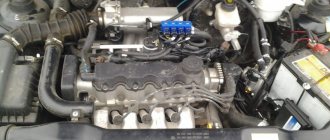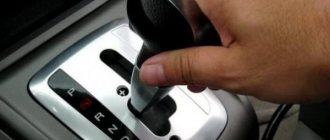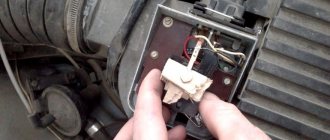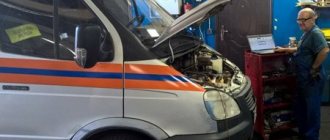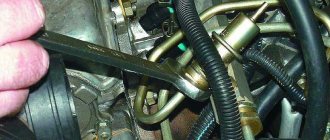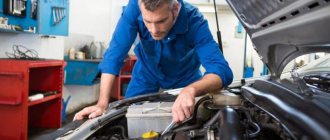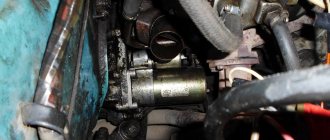More than half of motorists who choose, for example, a gazelle, switch their horses to gas. If you put a 120-liter cylinder on a long-wheelbase gazelle, the power reserve will exceed 450 km. However, when putting a gazelle on LPG, you should think about strengthening the springs. The standard five sheets may not cope with the gas-plus-gasoline combination. And the gazelle will not let you down. That is, gas-cylinder equipment, with all its advantages, requires a competent attitude.
Does it jerk when moving?
It often happens that a completely new and apparently intact car with gas-cylinder equipment, which starts perfectly when hot, suddenly behaves strangely when accelerating: it jerks when moving, tears, jumps at medium speeds, as if at zero. And the tank is full of fuel. And you were lucky if you didn’t have time to drive far from the gas worker while accelerating, however, according to the law of the sandwich, it usually jerks into the heat completely inopportunely - in the wilderness, or when climbing a mountain. If you switch to gasoline, the breakdown disappears.
The problem, of course, will not be resolved by itself and, in an amicable way, the car will need to be diagnosed. But there is a temptation to tinker with it yourself.
Before disassembling the gas system, make sure that the car runs smoothly on gasoline, both at idle and when hot.
Let's sum it up
Modern cars require high-quality fuel and good maintenance. If these factors of their operation are violated, problems with technical capabilities appear, the machines begin to show a variety of problems and, in general, do not want to serve. When the car jerks when driving on gas, it is not recommended to continue using the car. We need to find the reasons why transport behaves so inappropriately. After searching for the reasons, it will be possible to completely restore the HBO system and return it to normal operation. But this is only possible after a full diagnosis.
It is recommended to undergo a complete maintenance of the gas installation once every 3 years, including replacing all filters, checking sensors, setting and calibrating injectors, and overhauling the gearbox. Also in this process, the technician will search for air leaks, which may be the cause of various problems in the vehicle system with LPG. You should carefully consider the process of repairing and restoring gas equipment. Otherwise, operating the equipment will be impossible, and you will spend more and more money on gas due to increasing consumption. Have you ever experienced your car jerking at low speeds?
Help guys figure out the problem! If you accelerate strongly from low revs, the car jerks on the gas. At high speeds (from 2000 rpm) and on gasoline it drives without jerking.
Comments 34
All the best! HBO 4 auto Pajero 2. I recently installed an LPG (approximately 2 months), everything worked perfectly, the car flew, the consumption was excellent. But 2 weeks ago, something like this started brewing, when there was about 20-25 liters of gas left in the cylinder, the car started to jerk sometimes. I fill it up to full, the problem goes away. And a week ago the problem started again, it’s impossible to drive constantly, it stalls, it may not switch to gas at all, but when it switches, it stalls. There are no problems at all with gasoline. The spark plugs are almost new, as are the wires. The masters shrug their shoulders. Tell me if you know.
I also have the same thing, only after 3500 rpm the food is reset, adjusted again, I drive about 1000 km and everything repeats... I don’t know what this is
They say that for some reason the pressure sags and the injectors go astray
Yes, I also have the same crap, the 4th generation Lovato twitches and doesn’t drive normally. Everything is fine on gasoline. Priora
Have you tried it or was there a lot of resistance?
They punched through. when I removed the explosive wires I saw white stripes inside
Did you manage to win in the end?
Yes, we succeeded. It turned out to be a problem with the high voltage wires.
I had a similar problem when the valves sagged. Changed the cylinder head assembly
I have the same problem. If you press the gas too hard to 2 thousand revolutions, then the car stalls and does not move. Above these rpms everything is fine
I had the same crap. HBO lovato...and I changed the spark plugs and 2 sets of wires and a coil. The gap in the spark plugs changed the situation literally by 500-800 km... everything was solved by replacing the ignition coil... and there can be many reasons... I advise you to start with the wires and spark plugs... if the spark plugs are changed, then the wires. They say they glow in the night (you can measure the resistance). You can also play with the gap 0.7-0.9...then comes compression...this is provided that the gas pump specialists say that everything is fine...(they almost always say so)...I actually had a mysticism - I come to them, set up, go home everything is great, the car is standing still and the same problem...maybe it’s also due to the glow number of the spark plugs...you need to put colder ones under the gas...well, that’s a lyric...the car should run on LPG on stock spark plugs without changing the gap.
Jerks due to ignition
Experience proves that in eight out of a dozen options, a gas-powered car jerks during acceleration not even because of the gas, but because of trivial issues with the electrics: spark plugs, high-voltage armored wires, ignition coils and electric valves.
An electrical breakdown does not necessarily recur when accelerating on gasoline or idling. It’s just that gas itself ignites worse, ignites differently and burns much slower than gasoline, which is why the gas-air mixture turns out to be more modest, even at startup, even when it’s hot. When the engine is running, the gas-air mixture requires a higher voltage to ignite - 16 kV (14 kV for gasoline). But the combustion of the gas-air mixture gives a significantly higher temperature of the combustion chamber, for this reason the wear of conventional gasoline spark plugs is accelerated many times over. Therefore, it is important to install spark plugs on gas-cylinder equipment “cooler”, that is, with a lower heat index.
The use of special spark plugs recommended for installation in a car with LPG is not a marketing ploy, but an objective necessity. Such a candle differs not only in the gap, but often also in the design. Replacing it is easy.
A lower density of the gas-air mixture, especially during acceleration, requires an increased breakdown voltage, which exposes all weak ignition links to clean water. Which is another reason to think about special spark plugs, or at least about reducing the gap yourself. Often, missing sparks occur at medium speeds, which is due to the formation of carbon deposits on the spark plugs, which is why the spark strikes when it hits. Start small, cleaning and lubricating the coil contacts is useful, and even during jerks at medium speeds, this is simply an urgent measure.
Car jerking during acceleration
This problem can occur during a smooth increase in speed, which is accompanied by a sharp short-term twitching of the vehicle. In this case, the reason is due to the lack of constant supply of the fuel mixture to the float chamber of the engine. That is, the fuel is burned in the chamber much faster than the fuel pump distils a new stream. As a rule, the breakdown can be found in the design of the fuel pump.
Solving a fuel pump malfunction takes place in 3 stages:
Advice: when making repairs, do not try to repair holes in the old cylinder and install it in place. This may subsequently lead to a major overhaul of the entire engine structure.
Closing on the go
It jerks when it’s hot, which means no one is watching the resistance of the explosive wires and spark plugs when moving. Normally, the resistance of armored wires is up to 15 kOhm, spark plugs are up to 6.8 kOhm. The higher the resistance, the stronger it jerks, the sooner the closing coil will break. By the way, the resistance of spark plugs is increasingly burning out, and due to an increase in breakdown voltage, an interturn short circuit occurs in the coil. Every third person drives with it on gasoline, and they experience a mini-slip, sometimes with a twitch. On gas, this is immediately evident, because the combustion period is less than 1 ms and the first LPG in power mode will certainly have a pop, and the fourth one will fail and jerk.
The most important measure that significantly influences fuel consumption, efficiency and stability of gas engines is the ignition timing, which marks the time of ignition of the gas-air mixture. This indicator is based on a multi-level relationship with temperature, load and at what speed the engine is best tuned.
Incorrect adjustment of the advance angle often leads to gas detonation, followed by jerking, and the car jerks. This significantly reduces both power and resource, which engine could be more interesting.
Sensors - look towards electronics
The second reason for a car jerking on gas is the sensor system. In the 4th generation, several sensors are installed that transmit information to the ECU or to its own computer. The set may differ in different generations and modifications. For example, there is a gas mixture pressure sensor that controls the operation of the gearbox and supplies the mixture to the injectors. It is this that often causes problems with the car twitching at idle or low speeds. This sensor is also called a MAP sensor; it often fails.
The problem algorithm develops as follows:
- one of the parts of the MAP sensor burns out, which is responsible for measuring the gas pressure in the system, and also measures the temperature in more modern installations, which is also important for normal operation;
- further operation on gas becomes arbitrary, the speed can float or stop in any position, despite the optimal travel mode and good gas filling;
- the next stage - the sensor misses the readings of the mixture temperature, which causes the supply of fuel to the injectors that is not heated to the optimal temperature, this also causes combustion problems;
- the pressure on the injectors drops to critical values, and sometimes the supply is cut off altogether, this leads to an emergency switch to gasoline and errors in the gas system sensor system;
- This damages the sensor even more, the operating parameters of gas-cylinder equipment become unclear, and you have to drive on gasoline until visiting a service station.
But the MAP sensor is not the only electronic part that causes such unpleasant operating features of the car. There are also a number of other sensors, the set of which greatly depends on the manufacturer and modification of the LPG systems. If you have a low-cost setup, you can simply replace the sensor kit. If the cost of automation is high, it’s worth going for diagnostics and finding out which parts are causing problems in your car’s system. This way you will save money on buying unnecessary parts.
Gearbox, hit idle
If the engine jerks at idle, then it makes sense to clean (replace) the valve and adjust the idle speed. You also need to inspect the screw on the gearbox. Due to an accidental shift, a pressure drop occurs and, as a result, jerks. If the car jerks, you will have to reconfigure the gearbox and try to achieve clarity at idle. The gearbox may not warm up as required. Then you need to evaluate the path of antifreeze for kinks and circulation.
If the issue is not resolved by tuning, then all that remains is to completely change the repair kit in the gearbox so that the idle speed no longer bothers you.
Speaking about wires, it should be noted that it is not always possible to identify their disease using the traditional method - we look at how the engine behaves in the dark. Why, if the armored wires are not “fresh”, then they also need to be replaced. If possible, it would not hurt to first measure their resistance and check for breakdowns.
Solenoid valve
To check for a malfunction in the solenoid valve, you need to switch the car to gas and try the ignition. A good valve will click in a peculiar way. If it is peculiarly silent, then you need to inspect the contact connections and the integrity of the fuse.
It would be a good idea to clean all the filter units, because their clogging interferes with the flow, which sharply reduces the potential of the internal combustion engine, and the engine can stop completely.
A clogged filter can clog the gearbox, which leads to depressurization. It is important to be careful when cleaning filters with solvent. Perform all actions only after closing the valve on the cylinder.
Resolving identified problems
Once the cause has been identified, you can begin to eliminate it. In most cases, this work should be entrusted to specialists. After all, the reasons that at first glance were key are not always exactly what they are. Correct ignition tuning, carburetor adjustment, injector adjustment is something that is best entrusted to a knowledgeable person. If it was determined that the jerking was caused by dirty filters, then you can use an aerosol cleaner. It is sprayed into the air filter hole. Fuel tank additives also perform quite well. These additives clean the fuel line pipes and all other elements. XADO additives have proven themselves well.
Fine tuning
The other two cases out of our dozen, why the car jerks while driving, relate to a malfunction of the LPG itself, plus inaccuracies in the firmware of the electronic control unit. Problems with debugging the electronic control unit and erroneous calibration of injectors normally reveal themselves immediately, and if there is no suspicion of outside interference, then it is better to blame these factors as a last resort. If there is a need, the firmware can be reflashed, but with calibration you need to contact specialists.
ECU debugging is simplified by the fact that most modern devices have a huge number of different strategies and adaptations, including adaptation while driving, based on the vehicle’s on-board diagnostic system.
It is known and present in all instructions - with a normally adjusted LPG ECU, the injection time remains constant, whether on gasoline or on gas - achieving this is task number one.
Gaza Strip
Faults in gas equipment, as a rule, accumulate during operation. Mostly they relate to air leaks that occur through the connections of the entire gas equipment, in dried out or frayed hoses, in a deformed gearbox gasket, due to systematic freezing. It must be said that a good gas-air mixture is a mixture whose proportion normally corresponds to the optimal value for combustion. There should be 16.5 air per part of gas.
Otherwise, the mixture will either be thicker, increasing fuel consumption, or less often, depriving our car of its legitimate design agility and adding the notorious twitching.
With such symptoms, it would not be superfluous to check the car for tightness of the intake manifold from excess air.
Didn't you see the entrance?
To detect a breakdown, it is necessary to supply a smoke mixture under pressure into the system. And soon the inlet location will clearly reveal itself. You can normally “wash” all questionable surfaces and connections the old fashioned way. The “wounded” node will have to be updated.
Excess air can also enter in a “legal” way, through the air filter. To reduce it, a bushing is placed in the supply hose. When returning to gasoline, the bushing is removed. By the way, without monitoring the antifreeze level, when it decreases, the gearbox circuit mainly suffers. As a result, the gas does not have time to evaporate and remains in a liquid state.
So it turns out that our car is our car. And only we are responsible for its maintenance. Either we do it ourselves or we insist that the master correct his oversights efficiently.

